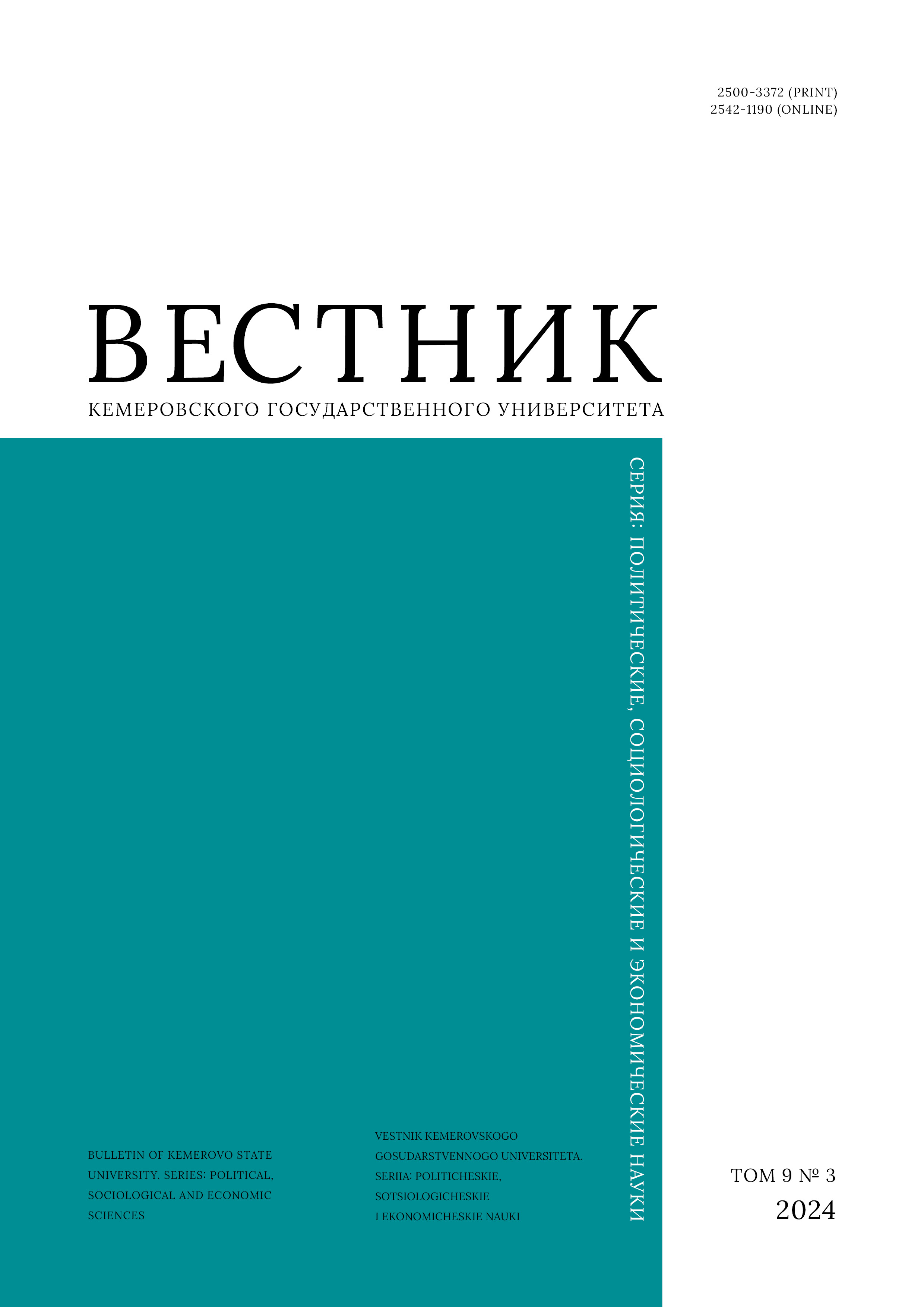Kemerovo, Russian Federation
Kemerovo, Russian Federation
Social disorganization triggers the development of subcultures, both positive and negative. As part of innovative adaptation, a person or a group may update certain sets of values, thus offering an alternative solution to some existing contradictions. Destructive socio-cultural associations, on the contrary, revise and oppose the generally recognized and accepted values, which leads to protest activity and what Peter Berger defined as anti-societies. The article describes the current diversity of delinquent youth subcultures in Russia and their development. The author designed a typology based on sociological interpretation, affiliations, and risks: 1) subcultures with career prospects; 2) subcultures of antisocial leisure activities; 3) subcultures that imitate certain totalitarian organizations; 4) subcultures of escapism; 5) subcultures of gender orientation; 6) street subcultures; 7) school-shooting subcultures. This classification takes into account those aspects of social life that deserve special scientific attention. Each subcultural community requires a special interdisciplinary approach that would consider its socio-cultural and legal adaptation mechanisms, causes, and online and offline functioning.
youth, subcultures, subcultural communities, delinquency, socially dangerous behavior, destructiveness, illegal activity, social networks
1. Mishchenko V. I. Features of delinquent behavior of students. Mir nauki, kultury, obrazovaniia, 2015, (5): 29–31. (In Russ.) https://elibrary.ru/uxuscl
2. Kanaian V. A., Kozlov A. A., Gushchin V. A., Bugakov I. S. Informal youth communities of St. Petersburg: Theory, practice, methods of preventing extremism. St. Petersburg: Komitet po molodezhnoi politike i vzaimodeistviiu s obshchestvennymi organizatsiiami, 2008, 277. (In Russ.)
3. Omelchenko E. L. Youth cultures and subcultures. Moscow: Institute of Sociology RAS, 2000, 261. (In Russ.)
4. Kubyakin E. O. Criminalization of youth culture in the context of modern information society. Society and law, 2010, (2): 263–267. (In Russ.) https://elibrary.ru/ndayef
5. Skakun A. S. Basic approaches to definition of the concepts of "youth culture" and "youth subculture". Russian journal of regional studies, 2014, (3): 164–173. (In Russ.) https://elibrary.ru/svroef
6. Cohen A. K. Delinquent boys: The culture of the gang. NY: The Free Press of Glencoe, 1955, 202.
7. Smelser N. J. Sociology. Moscow: Feniks, 1994, 687. (In Russ.)
8. Sztompka P. The sociology of social change. Moscow: Aspekt Press, 1996, 414. (In Russ.)
9. Cohen S. Folk devils and moral panics: The creation of the mods and rockers. 2nd ed. Moscow: HSE, 2022, 352. (In Russ.) https://doi.org/10.17323/978-5-7598-2926-3
10. Brake M. Comparative youth culture. The sociology of youth culture and youth subcultures in America, Britain and Canada. 1st ed. London: Routledge, 1985, 238. https://doi.org/10.4324/9780203408940
11. Shereuzheva O. H., Hubiev B. B. Social management of delinquent subcultures. The journal of scientific articles "Health and education millenium", 2016, 18(3): 149–153. (In Russ.) https://elibrary.ru/wfayfx
12. Becker H. S. Outsiders: Studies in the sociology of deviance. Moscow: Elementary forms, 2018, 270. (In Russ.)
13. Tolstykh A. V. A teenager in an informal group. Moscow: Znanie, 1991, 79. (In Russ.)
14. Sergeev S. A. Youth subcultures in the Republic of Tatarstan. Sotsiologicheskie issledovaniia, 1998, (11): 95–102. (In Russ.)
15. Khanipov R. A. Delinquency: Modern teenage communitiesand adolescent practices. Sotsiologicheskie issledovaniia, 2007, (12). (In Russ.) https://elibrary.ru/opcwqp
16. Mednikov S. V. Psychological components of aggressive behavior of football fans. Cand. Psychol. Sci. Diss. St. Petersburg, 2012, 144. (In Russ.) https://elibrary.ru/qfyryn
17. Omelchenko E. L. Is the Russian case of transformation of youth cultural practices unique? Monitoring of public opinion: Economic and social changes, 2019, (1): 3–27. (In Russ.) https://doi.org/10.14515/monitoring.2019.1.01
18. Roslyakova S. V., Chernikova E. G. Modern forms of deviant behavior of adolescents and their social prevention. Azimuth of scientific research: Pedagogy and psychology, 2021, 10(1): 209–212. (In Russ.) https://elibrary.ru/waryns
19. Zhilkin M. G., Shemchuk S. Yu. "PMC ‟REDAN”": The phenomenon of popularity of destructive subculture. Siberian law herald, 2023, (4): 78–84. (In Russ.) https://doi.org/10.26516/2071-8136.2023.4.78
20. Chirun S. N. AUE youth organization as an integrated phenomenon of the Russian postmodernity. Monitoring of public opinion: Economic and social changes, 2019, (1): 49–65. (In Russ.) https://doi.org/10.14515/monitoring.2019.1.03
21. Khagurov T. A., Chepeleva L. M., Ostapenko A. A., Rusiia N. T., Ivanova M. S., Kryshkina A. S., Khagurova S. T., Chepeleva A. A. AUE: Forms and causes of juvenile delinquency in modern Russia. The experience of sociological research. Krasnodar: KubGU, 2021. 212. (In Russ.) https://elibrary.ru/lqzpxf
22. Baeva L. V. Escapism in digital socium: From hikikomori to "groups of death". Values and meanings, 2018, (2): 39–54. (In Russ.) https://elibrary.ru/xqodnr
23. Nikishin V. D. Harmful information in Internet media: The "Overton window" and the relationship of destructive network currents. Lex Russica, 2022, (11): 131–148. (In Russ.) https://doi.org/10.17803/1729-5920.2022.192.11.131-148
24. Samygin S. I., Kasyanov V. V., Shilina N. A. Graffiti as a phenomenon of artistic subcultural practices in youth environment. Humanities, social-economic and social sciences, 2018, (8): 55–58. (In Russ.) https://elibrary.ru/saavxt
25. Skorik A. V. Graffiti as a subculture of provocation and outcry. Gumanitarnye nauki. Vestnik Finansovogo universiteta, 2016, 6(1): 63–69. (In Russ.) https://elibrary.ru/vprhcr
26. Karpova A. Yu., Maksimova N. G. School shooting in Russia: What matters? Power, 2021, 29(1): 93–108. (In Russ.) https://doi.org/10.31171/vlast.v29i1.7920
27. Chudinov S. I., Serbina G. N., Mundrievskaya Y. O. School shooting network on VKontakte: Case study of a fan community dedicated to "kerch shooter". Monitoring of public opinion: Economic and social changes, 2021, (4): 363–383. (In Russ.) https://doi.org/10.14515/monitoring.2021.4.1740
28. Grinenko U. B., Romero Reyes I. V. Semantic analysis of digital destructive content of school shooting in the social network "VKontakte". Psychology and law, 2021, 11(4): 180–195. (In Russ.) https://doi.org/10.17759/psylaw.2021110413
29. Silantev R. A., Chekmaev S. V., Ragozin Iu. G. Satanists are against bioscum. The history of misanthropic ideology in Russia, or Kill the bioscum! Moscow: Snezhnyi kom, 2022, 222. (In Russ.)




















